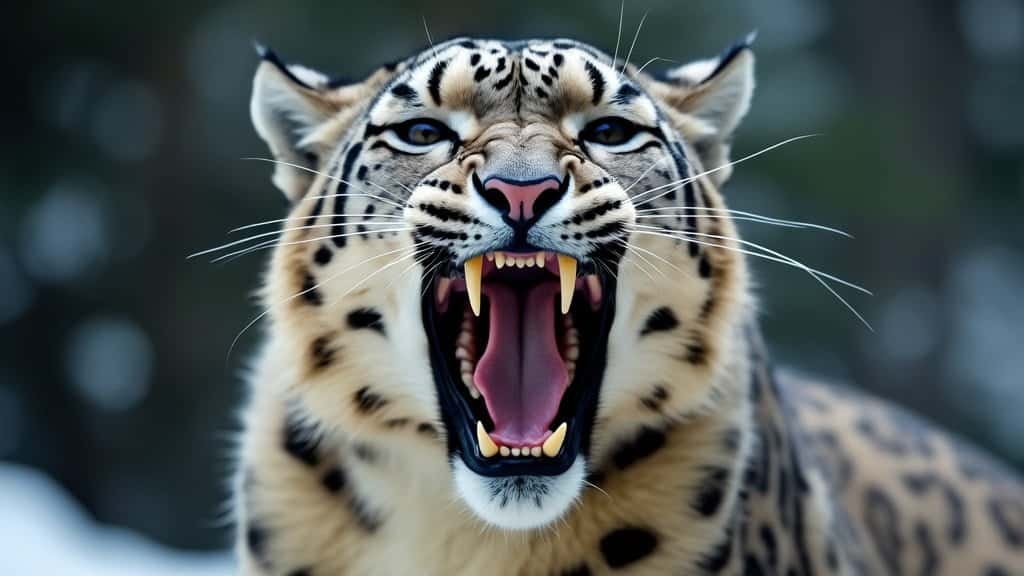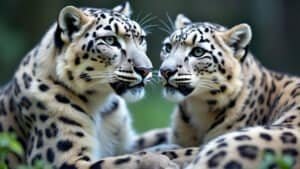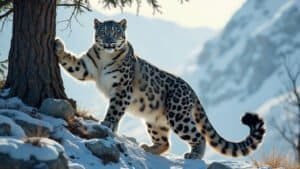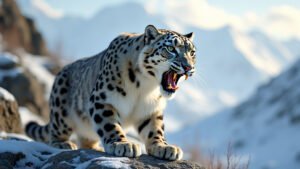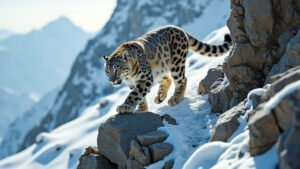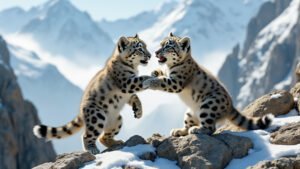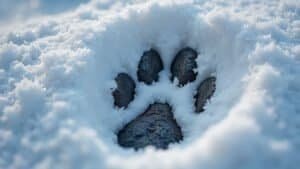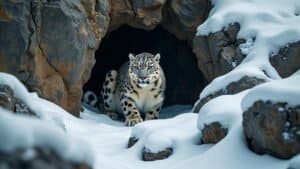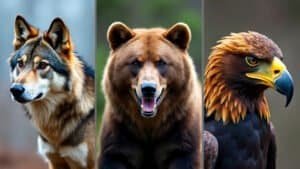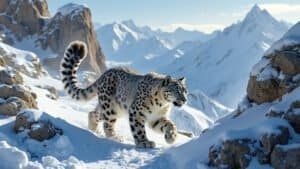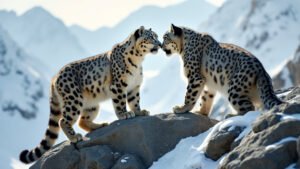Introduction
Snow leopards, elusive and majestic, inhabit the rugged mountain ranges of Central and South Asia. Understanding how these solitary big cats communicate in the wild provides insight into their behavior and survival strategies
This article will explore the various methods snow leopards use to communicate, including vocalizations, body language, and scent marking. We’ll also delve into the interactions between cubs and mothers, and how environmental factors influence their communication
By the end, you’ll have a comprehensive understanding of the intricate communication system of snow leopards in their natural habitat
Vocalizations
Snow leopards, known scientifically as Panthera uncia, inhabit remote mountainous regions where effective communication is vital for survival. Vocalizations are a key aspect of how these solitary felines interact with each other, despite their expansive and often isolated territories
Types of Vocalizations
Snow leopards utilize a range of vocal sounds to communicate, each serving distinct purposes. The most common vocalizations include:
Roars: Unlike other big cats, snow leopards cannot roar in the traditional sense. Instead, they produce a loud, piercing yowl known as a “sawing” sound, which resembles the noise of wood being cut
Chuffing: A friendly greeting sound, typically used between mothers and their cubs or between mates during the breeding season
Growls and Hisses: These sounds are primarily used to express aggression or warn other animals, including humans, to keep their distance
Meows and Purrs: These are softer vocalizations used mainly during close-range interactions, particularly between a mother and her cubs
Purposes of Vocalizations
Each vocalization serves a specific function within the snow leopard’s communication repertoire:
Territorial Claims: The sawing sound can travel long distances, allowing snow leopards to announce their presence and establish territorial boundaries without direct confrontation
Mating Calls: During the breeding season, males and females use chuffing and other vocalizations to signal their availability and readiness to mate
Parent-Offspring Interaction: Soft purrs and meows facilitate bonding and coordination between mothers and their cubs, helping them stay close and communicate needs such as hunger or distress
Defensive Signals: Growls and hisses are critical for deterring potential threats and avoiding unnecessary fights with other predators or snow leopards
Range and Effectiveness
The effectiveness of snow leopard vocalizations is influenced by the rugged terrain they inhabit
The sawing sound, for instance, can travel up to several kilometers, cutting through the mountainous landscape. This long-range communication is essential for maintaining territory in vast and sparsely populated areas
Researchers have studied these vocalizations to understand better the communication dynamics of snow leopards. Studies conducted by the Snow Leopard Trust and other conservation organizations have recorded and analyzed these sounds to map snow leopard territories and monitor population health
The data collected helps conservationists develop strategies to protect these endangered animals by understanding their communication patterns and habitat needs
Body Language
Snow leopards use body language extensively to communicate with each other. This non-verbal form of communication helps them convey a range of messages, from territorial boundaries to social interactions and mating behaviors
Common Body Language Signals
Snow leopards display various body language signals that are crucial for their interactions:
Tail Movements: The tail is a significant communication tool. A snow leopard holding its tail high might be signaling confidence or curiosity. Rapid tail flicking can indicate irritation or agitation
Ear Positions: Ear movements are subtle but informative. Ears flattened against the head usually signal aggression or defensive behavior, while ears pricked forward show interest or alertness
Posture: The overall body posture of a snow leopard can communicate its mood and intentions. A relaxed posture with legs stretched out indicates calmness, while a crouched position suggests readiness to pounce or defensive readiness
Interactions Between Snow Leopards
Interactions between snow leopards often involve a combination of body language cues:
Greeting Rituals: When snow leopards meet, they may perform a series of body language gestures such as nose touching or head rubbing, similar to domestic cats. These behaviors help reinforce social bonds, especially between mating pairs or mothers and cubs
Play Behavior: Cubs and young snow leopards engage in playful behavior that mimics hunting and fighting. This play is crucial for developing the skills needed for survival and helps establish social hierarchies
Aggressive Displays: When defending territory or during conflicts, snow leopards use aggressive body language such as raised hackles, open-mouth hissing, and swiping with their paws. These displays often deter actual physical fights, which can be risky and energy-draining
Understanding Aggressive vs. Friendly Gestures
Deciphering the difference between aggressive and friendly gestures is essential for understanding snow leopard interactions:
Friendly Gestures: Snow leopards use body language to convey friendliness, such as grooming each other (allogrooming), nuzzling, and sitting or lying close together. These behaviors are common among mothers and their cubs and between mating pairs
Aggressive Gestures: In contrast, aggressive body language includes direct staring, growling, and swatting. These gestures are typically used to establish dominance, defend territory, or ward off threats
Studies on snow leopard body language have been conducted by wildlife biologists and conservationists to better understand their behavior
Research published in journals like the “Journal of Mammalogy” and conducted by organizations such as Panthera and the Snow Leopard Trust provide insights into these elusive creatures’ social structures and communication methods
Scent Marking
Scent marking is a crucial communication method for snow leopards, allowing them to convey information about territory, identity, and reproductive status. This form of chemical communication is particularly effective in the vast, rugged landscapes where snow leopards live
Methods of Scent Marking
Snow leopards employ several techniques to leave scent marks in their environment:
Urine Spraying: One of the most common methods, urine spraying, involves the snow leopard backing up to a vertical surface such as a rock or tree and spraying urine. This leaves a distinct scent mark that can last for several weeks
Scratching and Rubbing: Snow leopards also use their claws to scratch trees, rocks, and the ground, leaving both visual and scent marks. They have scent glands in their paws that leave chemical signals when they scratch. Additionally, they rub their cheeks, which have scent glands, against objects to deposit their scent
Feces Deposition: Snow leopards often leave feces in prominent locations along their territory boundaries. These feces contain chemical cues that provide information about the individual’s identity, age, and reproductive status
Importance of Scent Marking
Scent marking serves several essential functions for snow leopards:
Territory Establishment: By marking their territory with scent, snow leopards can signal their presence to other snow leopards. This helps reduce direct confrontations over territory boundaries, as the scent marks provide a clear indication of occupancy
Mating Signals: During the breeding season, both males and females increase their scent marking activity. This communicates their reproductive status and helps individuals locate potential mates. Females in estrus will leave more frequent and conspicuous scent marks
Individual Identification: Scent marks convey information about the individual snow leopard, including its sex, age, and health status. This allows other snow leopards to identify who has been in the area and adjust their behavior accordingly
Territorial Implications
The territorial implications of scent marking are significant in the snow leopard’s communication system:
Territorial Overlap: Snow leopards have large home ranges that can overlap with those of other individuals. Scent marking helps maintain spatial organization within these overlapping territories by providing a non-visual means of communication
Avoidance Behavior: When a snow leopard encounters the scent mark of a dominant individual, it may choose to avoid the area to prevent conflict. This behavior helps snow leopards coexist in regions where territories overlap
Boundary Patrol: Snow leopards regularly patrol their territory boundaries, refreshing their scent marks to reinforce their presence and deter intruders
Research on snow leopard scent marking has been conducted using field studies and camera traps. For example, the Snow Leopard Conservancy and the Global Snow Leopard and Ecosystem Protection Program (GSLEP) have documented scent marking behaviors to understand territory dynamics and inform conservation strategies
Communication Among Cubs and Mothers
Communication between snow leopard mothers and their cubs is vital for the cubs’ survival and development. This interaction includes a combination of vocal signals, behavioral interactions, and learning processes
Vocal Signals
Mothers and cubs use specific vocalizations to communicate:
Chuffing: This soft, repetitive sound is commonly used by mothers to reassure and guide their cubs
Meows: Cubs often meow to signal their needs, such as hunger or distress, prompting a response from the mother
Growls and Hisses: These sounds are used by mothers to warn their cubs of danger or to discipline them
Behavioral Interactions
Behavioral interactions between mothers and cubs are essential for teaching survival skills:
Nurturing Behavior: Mothers spend a significant amount of time grooming and nursing their cubs, strengthening their bond and ensuring the cubs’ well-being
Play: Play is a crucial part of a cub’s development. Mothers engage in gentle play with their cubs, which helps the young ones develop hunting and fighting skills. Play behavior includes mock stalking, chasing, and pouncing
Guidance and Protection: Mothers lead their cubs to safe resting spots and guide them to food sources. They also protect their cubs from potential threats, teaching them how to avoid danger
Training and Learning Communication
Cubs learn communication skills and survival tactics by observing and interacting with their mother:
Hunting Skills: Mothers teach cubs how to hunt by demonstrating stalking techniques and allowing the cubs to practice on smaller prey. This training is critical for the cubs’ independence
Territory Familiarization: As cubs grow older, mothers take them on patrols around their territory, showing them scent marking locations and teaching them to recognize the scents of other snow leopards
Self-reliance: Gradually, mothers encourage cubs to become more independent by reducing the frequency of feedings and pushing them to hunt on their own
Research on mother-cub communication in snow leopards has been enhanced by camera traps and GPS collar tracking. Studies published in journals like “Animal Behaviour” and research conducted by organizations such as Panthera have provided valuable insights into the development and survival strategies of snow leopard cubs
Environmental Factors
The environment in which snow leopards live plays a significant role in shaping their communication strategies. Factors such as terrain, weather conditions, and habitat types influence how these big cats interact with each other
Impact of Terrain
Snow leopards inhabit mountainous regions, which present unique challenges and advantages for communication:
Echoes and Sound Travel: The rugged terrain can both hinder and enhance the travel of vocalizations. While mountains can create echoes that may confuse sound direction, they can also help amplify calls, allowing vocalizations to travel further
Visibility: The mountainous landscape often has limited visibility due to steep slopes, rocks, and vegetation. This limitation makes non-visual communication methods, such as vocalizations and scent marking, more critical
Movement: The challenging terrain affects the mobility of snow leopards, influencing where and how they communicate. They may prefer specific locations, like ridges and passes, for scent marking and vocalizing, where their signals can be more effectively disseminated
Weather Influences
Weather conditions in the snow leopards’ habitat can significantly impact their communication methods:
Wind: Wind can carry scents and sounds over long distances, enhancing the effectiveness of scent marking and vocalizations. However, strong winds can also disperse these signals, making them less reliable
Snow and Rain: Precipitation can wash away scent marks, requiring snow leopards to renew their markings more frequently. Snow cover can also dampen sounds, reducing the range of vocalizations
Temperature: Extreme cold can affect the energy levels and vocal behavior of snow leopards. They may conserve energy by reducing vocal activity during harsh weather conditions
Adaptations for Effective Communication
Snow leopards have adapted their communication strategies to cope with their challenging environment:
Scent Marking Techniques: They often choose sheltered spots for scent marking, where the marks are less likely to be affected by weather conditions. These locations include under overhangs, in rock crevices, and along sheltered trails
Vocalization Timing: Snow leopards may time their vocalizations to periods when weather conditions are most favorable for sound travel, such as during calm weather or specific times of day when wind conditions are optimal
Visual Markings: In addition to scent, snow leopards use visual markings, like scratch marks on trees and rocks, which are less affected by weather. These visual signals complement their scent marks, providing a multi-sensory communication approach
Research into the environmental factors affecting snow leopard communication is ongoing. Studies conducted by the Snow Leopard Trust and other conservation organizations are crucial for understanding how these big cats adapt to their harsh environments. These insights help in developing effective conservation strategies, ensuring the protection of their natural habitats and improving human-wildlife coexistence
Conclusion
Snow leopards employ a sophisticated array of communication methods to navigate their solitary lives in the harsh and remote mountainous regions they inhabit. Their vocalizations, including unique sounds like chuffing and sawing, play a crucial role in territorial establishment, mating, and parent-offspring interactions
Body language, from tail movements to ear positions, complements their vocal signals, enabling nuanced social interactions and conflict avoidance. Scent marking, with its multifaceted methods of urine spraying, scratching, and feces deposition, provides long-lasting territorial and identity markers that are essential in their vast ranges
The mother-cub dynamic is another fascinating aspect of snow leopard communication, where nurturing behaviors, vocal signals, and play help cubs learn essential survival skills. Environmental factors, such as terrain and weather conditions, further influence how snow leopards communicate, with adaptations ensuring their signals remain effective despite the challenging habitat
Research and conservation efforts continue to uncover the complexities of snow leopard communication, providing valuable insights for protecting these magnificent creatures. Understanding their communication strategies not only enriches our knowledge of their behavior but also informs conservation strategies to ensure their survival in the wild
